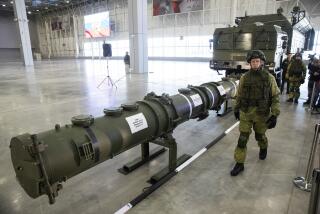Wasting Time on Arms Control : More or Fewer Weapons Won’t Make a Difference
President Reagan’s remarks at Glassboro High School have only heightened the confusion surrounding his arms-control policy. He said that we “must remain realistic about and committed to arms control,” and he added that “it appears that the Soviets have begun to make a serious effort” to reduce nuclear weapons. Once again he called for a second summit--”the location is unimportant.”
But only last month Reagan said he would abandon SALT II later this year, promising to base military procurement “on the nature and magnitude of the threat posed by the Soviet strategic forces and not on standards contained in the SALT structure.” This promptly annoyed the liberals in Congress, our allies and, of course, Moscow. Then again, Reagan added, if the Soviets would only behave themselves and begin observing the SALT limits, we would remain in compliance. At that point, Washington hands revived the words of former Atty. Gen. John Mitchell and applied them to Reagan: Watch what he does, not what he says.
By persistently advocating a good arms-control agreement for his signature, Reagan has let it be known that he accepts the major premise of the arms controllers: that the “nuclear threat” (as it is misleadingly called) is numerical, not political; and that the Soviets are willing conjointly to diminish that threat by dismantling some of their missiles.
A curious although unspoken world view underlies this pursuit of arms limits: missiles mysteriously multiply, perhaps like crabgrass, until they reach dangerous levels of proliferation. At that point diplomats from the Soviet Union and the United States must meet in Switzerland and agree to pare back the fecund weapons.
SALT II, unratified and technically expired, limits the United States and the Soviet Union to 1,200 missile launchers apiece. Arms-control theory assumes that we would all be much safer if these limits were lower, so that the Soviets only had, say, 1,000 missiles aimed at us. (Many of them carry multiple, independently targeted warheads.)
Why would this be an improvement? The liberals have been telling us for years that, between the United States and the Soviet Union, there are enough nuclear weapons to kill everyone in the world 10 times over. (The multiple varies; recently I saw it given as 67 times.) Paul Warnke, a former director of the Arms Control and Disarmament Agency and a great advocate of arms control, supports the notion that additional weapons would only make the rubble bounce.
If so, why is it threatening to us if the Soviets build more bombs and missiles? Let them build as many as they like. (They are expensive, after all.) A castle surrounded by frustrated archers is not likely to be further endangered if the archers multiply the number of their arrows. Assistant Defense Secretary Richard N. Perle, the leading opponent of SALT II in the Administration, in a way agrees with Warnke on this point. Added Soviet missiles would not add to the Soviet military threat, Perle told me last year. They crossed the “critical threshold” some years back.
The Challenger and related aerospace disasters may have drawn attention to another little-noted point. The simultaneous launch of hundreds, or even tens, of nuclear missiles is a difficult technological feat. U.S. missiles tested at Vandenberg Air Force Base have a way of misfiring. “I’m always amazed when we launch anything at all,” Maj. Ron Peck told the Los Angeles Times in 1984. “We had one Minuteman that we tried to launch every night for a year.” It is hard to imagine that the technologically less-advanced Soviets could launch a thousand missiles at once.
The main paradox of arms control is this: Within its framework, American security depends on Soviet consent. The Soviets, after all, would have to sign any agreement that would make the United States and the world a safer place. Safer from whom? The Soviets. Do we really believe that Soviet officials are such cooperative, peace-seeking souls? President Reagan evidently doesn’t, and he is right not to.
“We must remember,” he said at Glassboro, “that the Soviet government is based upon and drawn from the Soviet Communist Party--an organization that remains formally pledged to subjecting the world to Communist domination.”
Perhaps the President should be reminded that Soviet negotiators at Geneva are members of the Communist Party, too.
As I see it, Washington has nothing to gain from arms control and plenty to lose. We are told that our allies want it and that many in Congress want it. Yes, but this still does not tell us what military purpose such talks serve. A couple of members of the Administration have suggested to me that I might be right about arms control, but they explain that the people feel more secure when the two sides are talking. Why is it good policy to encourage delusion?
Arms talks help the Soviets because they misleadingly establish them as the co-guarantors of world peace. In fact, they are the sole threat to it.
Moreover, a great danger looms. Soviet leader Mikhail S. Gorbachev’s goal is plainly to get Reagan to add his signature to the 1972 ABM treaty, agreeing not to deploy the Strategic Defense Initiative for a further 15 years. (The Soviets could rely on the U.S. democratic process to enforce such a promise, while themselves remaining free from democratic restraints.) For their part, the Soviets would promise to reduce the number of their offensive weapons.
This does not sound like a good deal to me. Imagine that a mugger points his gun at you and asks for your money.
“I’m wearing a bullet-proof vest,” you reply.
“Watch out,” says the mugger. “I’ve got lots more guns at home.”
You look worried, so he adds: “Tell you what. Let’s make a deal. You take off your bullet-proof vest and I’ll dismantle some of the guns I have at home.”
“It’s a deal,” you say.
Meanwhile he still has his gun pointed at you.
Don’t fall for it, Mr. Reagan.
More to Read
Sign up for Essential California
The most important California stories and recommendations in your inbox every morning.
You may occasionally receive promotional content from the Los Angeles Times.










